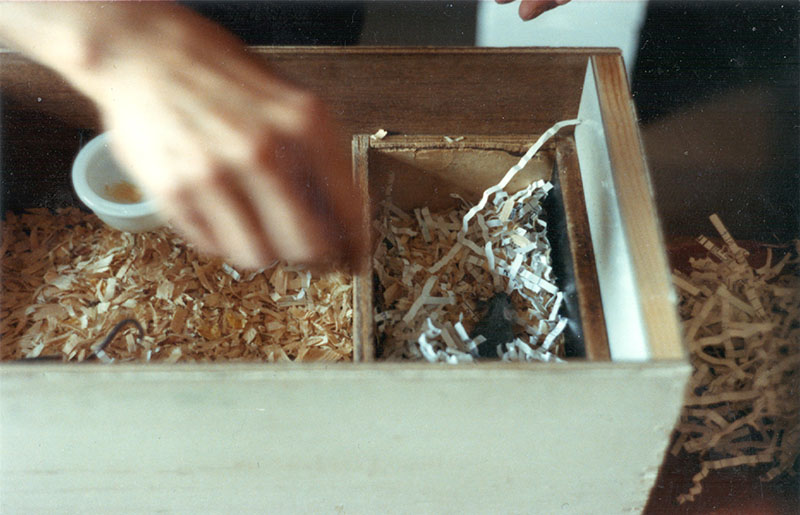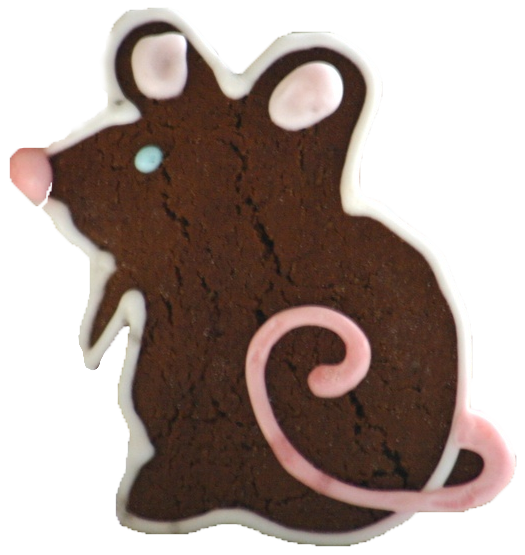HUSBANDRY
When exhibiting mice it is important that all animals are in peak condition. Learn about how exhibitors keep their mice and discover the symptoms of some of the ailments that mice suffer from, how to treat them and how it affects the show breeder and their stud.
WHAT DO I NEED TO GET STARTED?
Space
Most successful breeders have a shed or outbuilding to house their mice in. Nothing vast or fancy is required, just somewhere you have enough space to keep a minimum of ten to twelve boxes of mice with room to move around, store food and so on. If you are purchasing a shed specially for your mice, then an opening window is a bonus, providing light and ventilation on warm days. Buildings do not need to be heated and as long as they are not damp or draughty then the mice should continue to thrive. It is handy to have a few dustbins or containers in which to store food to prevent it from attracting wild visitors.

Time
You need to be able to devote enough time to your mice to meet their basic needs for food and water, clean boxes and bedding, and check your stock for any health issues. You will also need time to evaluate your mice, deciding which young ones to rear and which to cull. Although your foundation stock will only be a trio or two, think of the number of boxes you will need to build up to in order to do your chosen variety justice. Some people may only have time for one variety, while others choose to breed compatible varieties to maximise the return for the number of boxes they keep. If you have to fit the mice in around work, family and other hobbies and commitments then be sure to take this into account.
Stock
Obviously to start your show career you need to buy some foundation stock from established fanciers. Don’t get your mice from the first person who offers you some. Find out who’s winning with your chosen variety and approach them for both mice and advice; it will pay off in the long run. Even if you have to wait a month or two, be patient. Use the time to get all your boxes, feed and so on sorted out in preparation.
Money?
We often get asked how much show mice cost. The answer is not a lot. You will not need a lot of money to buy quality animals, though you will need to be a member of the NMC. The most expensive part about starting from scratch is getting housing sorted out for all the mice, though wooden and plastic breeding boxes can be bought or made quite cheaply. Food is an ongoing cost and obviously depends on the number of mice you have. Fanciers will often buy ‘straights’ from equine and farm supply shops and create their own mix that is free from preservatives and tailored to exhibition mice (at a fraction of the cost of commercial feeds).
Feeding
Every fancier will feed his mice differently, even when using the same basic ingredients. There is no one ‘right’ way of feeding your stud and what works for one person and their mice might not work for others.
Oats
Most mouse breeders use oats as a main part of their mix. Bruised, rolled, whole or clipped oats are equally useful, provided they are of good quality.
Seed
Mixed wild bird seed provides natural oils and fats. This contains millet and sunflower seeds amongst others.
Dog food
Dry complete dog food provides animal protein, which wild mice get by eating insects. Other mixers and biscuits are also relished by mice.
Pobs
Pobs is the word used to describe a mix of stale bread and milk, sometimes with other ingredients such as raw egg, soaked and then squeezed out. This is then given to mice to provide moisture as well as food.
Pellets
Some fanciers use high-protein pelleted food which is very convenient to use but may not be readily available, depending on your location. If you decide to use pellets you would be advised to use laboratory-type breeding boxes, which have a dispensing hopper for the pellets. The mice will have to work for their food; also, scattered pellets quickly disintegrate and become inedible.
Other foods and additives
Any dry food intended for small animals can be given in small quantity, along with biscuits, crackers, nuts, fat such as wild bird suet, with or without mealworms. Try to avoid foods which have a lot of salt or sugar, Essentially, anything goes as long as there is not too much of it.
What else do I need to think about?
Cleaning out and upkeep
Mice do need to be cleaned out weekly. You must be able to keep up with regular cleaning, and if you plan to take a holiday find someone to care for the mice in your absence. This can be difficult with a large number of animals so is worth keeping in mind if you tend to travel often.
Travel
Shows are spread across England and some locations can be difficult to get to via public transport. Having your own transport is a definite advantage if you want to show regularly. If you don’t you may be able to share a car with a nearby fancier in return for a contribution to the cost of petrol.
Housing mice
For exhibition and breeding
When rearing litters mice tend to feel safer and more secure in smaller spaces. This does not mean that you should overcrowd your mice, but it does mean that you will use a different set-up to those who solely keep non-breeding pets. The typical breeding box for a UK fancier is around 18 x 12 inches. This has a nest area filled with hay, shredded paper or whatever bedding is provided and will house either a breeding trio (a buck and two does) that have been mated, or a doe/pair of does and their offspring. Since litters are reduced there will be adequate space for the growing young ones until they are weaned.
Exhibitors also tend to keep something called a running on box (or boxes). This is a larger enclosure used to hold does from several litters who are weaned but still too young to breed. This allows the fancier to see which mice are the best once they have begun to mature; for example to choose the best colour/tan, type, size or any other aspect that is being selected for.


The material that your breeding boxes are made of is your choice. Traditionally wooden boxes are used for mice, made from good quality plywood and partially painted inside to protect the wood from soaking up the moisture produced by the mice. With the availability of commercial plastic tanks, lab cages and plastic storage boxes that can be modified for mice, a growing number of fanciers are using plastic. This is lighter and easier to clean. Plastic boxes can be modified fairly easily using a dremel type tool, 6mm wire mesh (hardware cloth in the US) and cable ties. A large rectangle is cut out of the lid and covered with wire mesh. Smaller, higher up ‘windows’ can also be cut out of one or more sides of the box if desired.
Mice are transported to shows in Maxey cages (designed by the founder of the NMC, Walter Maxey). These are small wooden boxes with a slanted metal grill to the front, painted specifically in middle Brunswick green outside and signal red inside. Each Maxey holds a single mouse. Maxeys are the only permissible cage for showing mice, and exhibitors can make their own, buy them through the club or other fanciers, or sometimes hire them at shows. It is not uncommon for exhibitors to have over 20 Maxeys, and some have many more.
 We use cookies to ensure that we give you the best experience on our website. If you continue to use this site we will assume that you are happy with it.
We use cookies to ensure that we give you the best experience on our website. If you continue to use this site we will assume that you are happy with it.